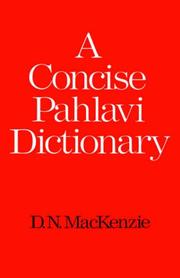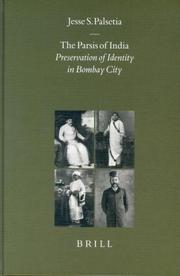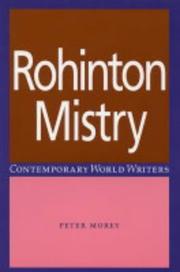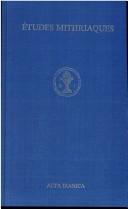| Listing 11 - 18 of 18 | << page >> |
Sort by
|
Book
ISBN: 0271089709 0271089687 9780271089683 9780271089706 9780271089430 0271089431 Year: 2021 Publisher: University Park, Pa The Pennsylvania State University Press
Abstract | Keywords | Export | Availability | Bookmark
 Loading...
Loading...Choose an application
- Reference Manager
- EndNote
- RefWorks (Direct export to RefWorks)
"Examines Europe's discovery of ancient Iran, first in philology and then in art history, and explores the Persian Revival movement in light of imperial strategies of power, selfhood, and statehood in British India and Zand-Qajar-Pahlavi Iran"--
Architecture --- Imperialism and architecture --- History --- Iran. --- Aryan. --- British India. --- Gothic Revival. --- Indo-European. --- Iranian architecture. --- Naser al-Din Shah. --- Orient-or-Rome debate. --- Pahlavi. --- Parsi architecture. --- Parsi. --- Persia. --- Persian Revival. --- Qajar. --- Reza Shah. --- Strzygowski. --- Zand. --- colonialism. --- copy. --- fire temple. --- imperialism. --- nationalism. --- revivalism. --- style. --- travelogues to Iran. --- architecture [discipline] --- architectural history --- anno 1800-1999 --- Iran
Book
ISBN: 0882060058 Year: 1977 Volume: 3 Publisher: Delmar, N.Y. : Caravan Books,
Abstract | Keywords | Export | Availability | Bookmark
 Loading...
Loading...Choose an application
- Reference Manager
- EndNote
- RefWorks (Direct export to RefWorks)
Pahlavi language --- Parthian language --- Pehlevi (Langue) --- Parthe (Langue) --- Syntax. --- Syntaxe --- -Parthian language --- -Iranian languages, Middle --- Huzvaresh --- Middle Persian language --- Parsi language --- Pazend --- Pehlevi language --- Persian language --- Extinct languages --- Iranian languages, Middle --- Syntax --- Middle Persian --- Pahlavi --- -Syntax

ISBN: 0197135595 9781136613968 113661396X 9780197135594 1138991589 0203462513 9780203462515 9781136613913 9781136613951 9781138991583 1322163839 1136613951 Year: 1971 Publisher: London: Oxford university press,
Abstract | Keywords | Export | Availability | Bookmark
 Loading...
Loading...Choose an application
- Reference Manager
- EndNote
- RefWorks (Direct export to RefWorks)
First published in 2004. Routledge is an imprint of Taylor & Francis, an informa company.
Pahlavi language --- English language --- Dictionaries --- English --- Pahlavi --- Pahlavi. --- English. --- Germanic languages --- Huzvaresh --- Middle Persian language --- Parsi language --- Pazend --- Pehlevi language --- Persian language --- Extinct languages --- Iranian languages, Middle --- Middle Persian --- Pahlavi language - Dictionaries - English --- English language - Dictionaries - Pahlavi

ISBN: 9004121145 9004491279 Year: 2001 Publisher: Leiden ; Boston : Brill,
Abstract | Keywords | Export | Availability | Bookmark
 Loading...
Loading...Choose an application
- Reference Manager
- EndNote
- RefWorks (Direct export to RefWorks)
Parsees --- Zoroastrians --- Ethnic identity. --- History. --- Parsis --- India --- identity --- urbanism --- Punchayet --- social reform --- education --- reform of religion --- the Rangoon Navjote case --- political nationalism --- ideology --- Dadabhaj Naoroji --- Pherozeshah Mehta --- D.E. Wacha --- Parsi laws
Book
ISBN: 8170310223 Year: 1986 Publisher: Delhi Sri Satguru Publications / Indian Books Centre
Abstract | Keywords | Export | Availability | Bookmark
 Loading...
Loading...Choose an application
- Reference Manager
- EndNote
- RefWorks (Direct export to RefWorks)
Buddhism --- the Four Noble Truths --- history of Buddhism --- Sigalovada Suttanta --- social ethics --- Buddha --- Sankara --- God --- modern Hinduism --- Dhammapada steps --- Buddha Society lecture --- Swami Vivekananda --- Bhagwan Budha --- Buddhist yoga --- the Fetters --- Buddhaghosa's Simile of the Calf-Pen --- immortality --- Anatta --- the First Buddhist Council --- emperor Asoka --- India --- Sanchi --- Tibet --- Goutama --- Parsi scriptures --- secularization --- social strata --- Buddhist thought

ISBN: 0719067154 0719067146 9780719067143 9780719067150 9786610734603 1781700583 1280734604 1847791034 9781526120656 9781847791030 9781280734601 9781781700587 1847795919 1526120658 Year: 2004 Publisher: Manchester ; New York : New York : Manchester University Press ; Distributed exclusively in the USA by Palgrave,
Abstract | Keywords | Export | Availability | Bookmark
 Loading...
Loading...Choose an application
- Reference Manager
- EndNote
- RefWorks (Direct export to RefWorks)
This study - the first of its kind - situates Rohinton Mistry's writing in its cultural and historical context. It explores key features, such as the legacy of Zoroastrianism, Parsi anglophilia, recent Indian history, the conventions of oral storytellling common to Persia and South Asia, and the experience of migration which now sees him living in Canada. The texts are viewed through the lens of diaspora and minority discourse theories to show how Mistry's writing is illustrative of marginal positions in relation to sanctioned national identities.
English Literature --- English --- Languages & Literatures --- 820 "19" MISTRY, ROHINTON --- Engelse literatuur--20e eeuw. Periode 1900-1999--MISTRY, ROHINTON --- Mistry, Rohinton, --- Criticism and interpretation. --- Rohinton Mistry, --- מיסטרי, רוהינטון, --- Literary studies: fiction, novelists & prose writers --- literature --- mistry --- postcolonial --- parsi --- India --- Jahangir --- Mumbai --- Parsis --- Zoroastrianism --- Literature --- Literary Studies: Fiction, Novelists & Prose Writers --- LITERARY CRITICISM / Asian / General --- Asia --- LITERARY CRITICISM / Asian / General. --- Family Matters. --- Fine Balance. --- India. --- Indian political history. --- Man Booker Prize. --- Parsee. --- Rohinton Mistry. --- diaspora. --- migration. --- postcolonial literature.
Book
ISBN: 9780691164465 0691164460 9780691211985 9780691234441 0691234442 0691211981 Year: 2020 Publisher: Princeton, N.J. Princeton University Press
Abstract | Keywords | Export | Availability | Bookmark
 Loading...
Loading...Choose an application
- Reference Manager
- EndNote
- RefWorks (Direct export to RefWorks)
"How do gods and spirits come to feel vividly real to people-as if they were standing right next to them? Humans tend to see supernatural agents everywhere, as the cognitive science of religion has shown. But it isn't easy to maintain a sense that there are invisible spirits who care about you. In How God Becomes Real, acclaimed anthropologist and scholar of religion T. M. Luhrmann argues that people must work incredibly hard to make gods real and that this effort-by changing the people who do it and giving them the benefits they seek from invisible others-helps to explain the enduring power of faith"--
Spirituality --- Presence of God --- 291.21 --- 291.21 Onderwerp van de godsdienst: goden en geesten; aanbidding; godensagen --- Onderwerp van de godsdienst: goden en geesten; aanbidding; godensagen --- Spiritual-mindedness --- Philosophy --- Religion --- Spiritual life --- God --- Schechinah --- Shechina --- Shechinah --- Shekhinah --- Shekina --- Shekinah --- Presence --- Omnipresence --- Spirituality. --- Good Parsi. --- Of Two Minds. --- Our Most Troubling Madness. --- Persuasion of the Witch’s Craft. --- anthropology of mind. --- anthropology of religion. --- ethnography. --- feeling the presence of god. --- how prayer works. --- psychological anthropologist. --- psychological anthropology. --- psychology of prayer. --- psychology of religious experience. --- psychology of seeing god. --- understanding religious experience. --- understanding religious practice. --- what happens to religious worshippers. --- why prayer works. --- UmU kursbok --- Presence of God. --- Faith --- 291.12 --- 291.6 --- 291.6 Godsdienstwetenschap: religieuze organisatie; religieuze personen --- Godsdienstwetenschap: religieuze organisatie; religieuze personen --- 291.12 Religieus gevoel. Godsdienstig gevoel: vrees; eerbied; liefde; vertrouwen; onderdanigheid --- Religieus gevoel. Godsdienstig gevoel: vrees; eerbied; liefde; vertrouwen; onderdanigheid --- Christian spirituality

ISBN: 9004056890 9004039023 9004043284 9004043985 9004045384 9004048170 9004048189 9004043292 9004043934 9004039007 9004039015 9004041966 9004043942 9004043993 9004056068 9004045392 9004045406 9004056297 9004057617 9789004043992 9789004039025 9789004043947 9789004045385 9789004045392 9789004048188 9789004048171 9789004056893 9789004057616 9789004056060 9789004056299 9789004045408 9789004041967 9789004039001 9789004039018 9004671390 9004671358 9004672036 9004671048 9004671382 9004670971 9004672028 900467098X 9004671404 900467134X 9004671412 9004672079 9004671366 9789004671362 9789004672079 9789004671416 9789004671409 9789004671355 9789004671393 9789004671386 9789004671041 9789004671348 9789004672031 Year: 1978 Volume: 4-7 1-4 Publisher: Leiden : Brill,
Abstract | Keywords | Export | Availability | Bookmark
 Loading...
Loading...Choose an application
- Reference Manager
- EndNote
- RefWorks (Direct export to RefWorks)
Scholarly studies of topics in the art, archaeology, ancient history and linguistics of the Iranian region.
Mithraism --- Congresses --- Art, Archaemenid. --- Buddhism --- Buddhist literature, Sogdian --- Inscriptions, Pahlavi. --- Iranian philology. --- Kings and rulers in art. --- Manichaeism --- Manichaeism. --- Pahlavi language --- Parthian language --- Sufis --- Sacred books. --- History and criticism. --- Early works to 1800. --- Congresses. --- Etymology. --- Glossaries, vocabularies, etc. --- Orthography and spelling. --- Phonology. --- Readers --- Biography. --- Manichéisme --- Zoroastrianism --- Zoroastrisme --- Zoroaster --- Avesta --- Iranian philology --- Philologie iranienne --- Early works to 1800 --- Ouvrages avant 1800 --- Glossaries, vocabularies, etc --- Reader in Manichaean Middle Persian, and Parthian --- Soufis --- Biography --- Biographies --- Iran --- Religion --- Antiquities --- Civilization --- Antiquités --- Civilisation --- Inscriptions, Pahlavi --- Inscriptions pahlavi --- Orthography and spelling --- Phonology --- Bouddhisme --- Sacred books --- History and criticism --- Livres sacrés --- Indo-European languages --- Indo-Iranian philology --- Langues indo-européennes --- Philologie indo-iranienne --- Etymology --- Etymologie --- Indo-European philology --- Indo-Europeans --- 491 --- Aryan philology --- Aryans --- Civilization, Aryan --- Civilization, Indo-European --- Indo-Germanic peoples --- Caucasian race --- Ethnology --- Aryan languages --- Indo-Germanic languages --- Kinship --- Languages Other languages Indo-European --- 491.53 --- Iranian languages, Middle --- Huzvaresh --- Middle Persian language --- Parsi language --- Pazend --- Pehlevi language --- Persian language --- Extinct languages --- Languages Middle Iranian languages --- Middle Persian --- Pahlavi --- Reader in Manichaean Middle Persian, and Parthian. --- 955 --- History Iran --- Antiquities. --- Civilization. --- -Sufis --- -Pahlavi language --- -Parthian language --- -Manichaeism --- -Buddhist literature, Sogdian --- -Buddhism --- -Zoroastrianism --- Art, Archaemenid --- Kings and rulers in art --- 291.0955 --- Kings in art --- Mazdaism --- Mazdeism --- Religions --- Dualism (Religion) --- Philosophy, Ancient --- Eranian philology --- Indo-Aryan philology --- Buddha and Buddhism --- Lamaism --- Ris-med (Lamaism) --- Sogdian Buddhist literature --- Sogdian literature --- Sufism --- Religion Comparative religion Iran --- Christianity --- Zartusht --- Zarathustra --- Zarādusht --- Zarathoustra --- Zoroastre --- Zerdüşt --- Zarathushtra --- Zurtasht --- زرادشت --- زرتشت --- 295 --- 295.4 --- 295.4 Zoroastrisme. Mazdaisme. Zend-Avesta. Zarathoestra --- Zoroastrisme. Mazdaisme. Zend-Avesta. Zarathoestra --- Religion Zoroastrianism --- Zoroaster. --- Readers&delete& --- Iran. --- 297.4092 --- Religion Islam Ethics and religious experience, life, practice Persons --- 299.15 --- 295.2 --- 295.2 Mithras-cultus --- Mithras-cultus --- Mithras (Zoroastrian deity) --- Religion Mithraism --- Cyrus, --- 491.5 --- Languages Iranian --- 294.3 --- 091 <41 LONDON> --- 091 =915 --- 091 =915 Handschriftenkunde. Handschriftencatalogi--Iraans. Perzisch --- Handschriftenkunde. Handschriftencatalogi--Iraans. Perzisch --- 091 <41 LONDON> Handschriftenkunde. Handschriftencatalogi--Verenigd Koninkrijk van Groot-Brittannië en Noord-Ierland--LONDON --- Handschriftenkunde. Handschriftencatalogi--Verenigd Koninkrijk van Groot-Brittannië en Noord-Ierland--LONDON --- Buddhist literature --- Religion Buddhism --- Avesta. --- República Islâmica do Irã --- Irã --- Persia --- Northern Tier --- Islamic Republic of Iran --- Jumhūrī-i Islāmī-i Īrān --- I-lang --- Paras-Iran --- Paras --- Persia-Iran --- I.R.A. --- Islamische Republik Iran --- Islamskai︠a︡ Respublika Iran --- I.R.I. --- IRI --- ايران --- جمهورى اسلامى ايران --- Êran --- Komarî Îslamî Êran --- Pahlavi language - Readers - Manichaeism --- Parthian language - Readers - Manichaeism --- Buddhist literature, Sogdian - History and criticism --- Buddhism - Sacred books --- Manichaeism - Early works to 1800 --- Mithraism - Congresses --- Pahlavi language - Phonology --- Pahlavi language - Etymology --- Pahlavi language - Orthography and spelling --- Avesta. Yasna. Gatha --- Critique, interprétation, etc. --- Sources --- Abū Saʿīd Faḍl Allāh ibn Abī al-H̱ayr (0967-1050?) --- Mystique --- Islam --- Parthe (langue) --- Langues iraniennes moyennes --- Textes --- Persan (langue) --- Jusqu'à 651 --- Jusqu'à 651 --- Langues indo-iraniennes --- Pehlevi (langue) --- Mithra (divinité zoroastrienne) --- Inscriptions sassanides --- Sogdien (langue) --- Asie centrale --- Histoire --- Cyrus, - King of Persia, - d. 529 B.C. --- Mani, active 3rd century. --- Manichaeism Hymns. --- Parthian language. --- Texts. --- Indo-European philology. --- Kinship. --- Buddhist literature, Sogdian. --- Manuscripts, Sogdian.
| Listing 11 - 18 of 18 | << page >> |
Sort by
|

 Search
Search Feedback
Feedback About UniCat
About UniCat  Help
Help News
News